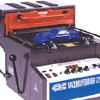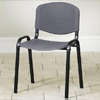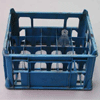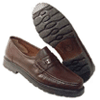|
Thermoplastics
Thermoplastics can
be heated and shaped many times. Thermoplastics
will soften when it is heated and can be shaped
when hot. The plastic will harden when cooled,
but can be reshaped because their is no links
between the polymer chains. Some common thermoplastics
are ABS (acrylonitrile butadienestyrene), Nylon
(polyamide), acrylic (polymethyl methacrylate),
uPVC (polyvinyl chloride), polystyrene, polypropylene
and cellulose acetate.
| Thermoplastic |
Thermoplastic properties |
Thermoplastic uses |
Example product |
| Polymethyl methacrylate
(Acrylic) |
Stiff, hard but scratches
easily, durable, brittle in small sections,
good electrical insulator, machines and polishes
well. |
Used for signs, covers
of storage boxes, aircraft canopies and windows,
covers for car lights, wash basins and baths. |
 |
| High impact polystyrene
(HIPS) |
Light but strong plastic.
Widely available in sheet softens at about
95 degrees. |
Used for vacuum forming.
Common for school projects which include products
outer casings or packaging. |
 |
| Polypropylene
(PP) |
Light, hard but can scratch
easily, tough, good resistance to chemicals,
resists work fatigue. |
Used for medical equipment,
laboratory equipment, containers - especially
with built-in hinges, 'plastic' seats, string,
rope, kitchen equipment. |
 |
Polythene:
- low density (LDPE)
|
Tough, good resistance
to chemicals, flexible, fairly soft, good
electrical insulator. |
Used for packaging, especially
bottles, toys, packaging film and bags. |
 |
Polythene:
- high density (HDPE)
|
Hard, stiff, able to be
sterilised. |
Used for 'plastic' bottles,
tubing, household equipment and milk crates. |
 |
| PVC |
Stiff hard wearing. Plasticiser
can be added to create a softer more rubbery
material. |
Used for air and water
pipies, shoe soles, blister packaging. |
 |
Memory tip: Remember Paps Hat !
P - Polythene
A - Acrylic
P - Polypropylene
S - Shaped many times
H- HIPS
A - ABS (acrylonitrile
butadienestyrene)
T- Thermoplastics
|
|








